These are the sites that you would see when doing the bicycle tour, in the order you would see them. You may like to take a look before you go out for your ride.
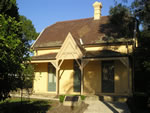 | Macquarie Street GatehouseThe gatehouse was built in 1887. |
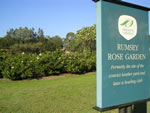 | Rumsey Rose GardenThe many roses were donated by the late Heather and Roy Rumsey, from a Dural nursery. |
 | ObservatoryThe observatory was built by Governor Brisbane, a distinguished astronomer, in the 1820s. Brisbane was the first governor to reside permanently in Parramatta. It was demolished in the 1840s. The transit stones are all that remains. A telescope and clock from the observatory can be found in the Sydney Observatory at Observatory Hill. This is the marker for where the Observatory built by Gov Brisbane was located. Interestingly, the Sydney Observatory, which houses relics from the Parramatta one including a telescope and clock, reckons this marker is in the wrong place and marks the kitchen instead of the observatory! |
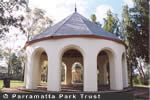 | Bath HouseAlso built for Governor Brisbane in 1823 to soothe his arthritis. Designed by convict architect Francis Greenway, it had a twin domes roof and grand circular windows. |
 | Boer War MemorialUnveiled in 1904, the doric columns were from the original Parramatta Courthouse (built in 1837) and replaced in 1898. Cannons are from the shore batteries that protected Port Jackson in the 1850s. |
 | William Hart MemorialWilliam Hart was a Parramatta dentist who was the first Australian to fly a plane and held the first pilot's licence in Australia. This memorial commemorates his flight from Penrith to Parramatta Park on 4 Nov 1911. His journey then continued on to Sydney showgrounds. |
 | Dairy PrecinctGeorge Salter built the cottage between 1798 and 1806, and grew wheat and maize. He sold it to Governor Macquarie in 1813 who converted it into a dairy with a sunken milk room. This is visible under the Rangers Cottage (latter built in 1875). |
" | Wisteria GardensThese gardens were originally built for the Superintendent of the Parramatta Lunatic Asylum, in 1906. The wisteria plants were brought from Japan by his daughter. The gardens are only open the last two weekends in September (during the Wisteria festival). You can get there via the Cumberland Hospital entrance at other times, but they really look their best in September. |
"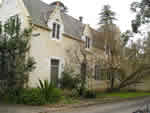 | Norma Parker CentreThis was the Roman Catholic Orphanage from 1844 till 1882. It later became the notorious Parramatta Girls Home. It has been a correctional facility since the 1980s. |
"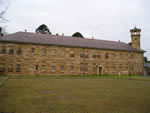 | Male Ward No. 1From 1804 female convicts were housed in the original Female Factory, atop the first gaol on the site of Prince Alfred Park. By 1817 this had become overrun, and in 1818 Gov Macquarie instructed Francis Greenway to design an institution for 300 female convicts. This was completed in 1821. It ceased to be a prison in 1848 (transportation had ceased in 1840), and it became part of the Parramatta Lunatic Asylum until it was demolished in 1883. Some of the walls from the Female Factory remain. The sandstone blocks from the Female Factory were used to build the Male Ward No. 1. The clock which graced the front arch of the Female Factory was transferred into a purpose built tower over the northern corner of Ward 1. This clock was made in London in 1820, the bell in 1821. The clock was one of 5 given to the colony by King George IV in 1822. The other four are in St John's Cathedral Parramatta, St Matthew's Church Windsor, St Luke's at Liverpool, and Government House Hobart.[The site is in Cumberland Hospital's property - please check permissions with them] |
" | Parramatta GaolThe gaol was built by James Houison and Nathaniel Payten between 1837 and 1853. |
 | Old Government HouseOld Government House is Australia's oldest publicly-owned building. The original was built for Arthur Phillip in 1790. While it was being built, Governor Phillip lived with Henry Dodd, the farmer who planted the first crops in Parramatta. (Henry died in 1792 and is buried in St Johns Cemetery, in the oldest remaining marked grave in Australia). Phillip's building collapsed and in 1799 Governor Hunter replaced it with the Georgian structure present today. Governor Macquarie added significantly to it, to complete in 1818 the buildings that are seen today. |
 | Lady Fitzroy MemorialGovernor Fitzroy's wife was killed in 1847, starting out on a journey to St James Church (city) for a wedding. Her carriage overturned when the horses bolted. Governor Fitzroy was the last governor to reside in Old Government House in Parramatta. |
 | Tudor GatehouseIt was built in 1885 and designed by Gordon McKinnon, a Parramatta architect. There are four sets of gates into the Governor's Domain (now Parramatta Park) - on the western end, the southern end (Pitt St), and south (Great Western Highway). |
 | BrislingtonBuilt in 1821, this is the oldest residence in central Parramatta. It was owned by doctors from 1851 to 1949, mostly by Dr Walter Brown and his descendants. In 1949 it transferred to Parramatta Hospital and is now a medical and nursing museum with memorabilia dating back to the 1880s. |
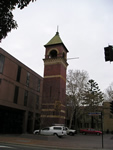 | Courthouse TowerThis tower is all that remains of Parramatta's second court house, which was built in 1890. The first was built in 1837 by Houison and Payten, in Church St. Part of a wall still remains (see Courthouse Wall). |
 | Woolpack InnReputed to be Australia's oldest licensed hotel, it was originally established in 1796 as the Freemason Hotel, and was given its current name in 1821. It was moved to its current site for the construction of the second courthouse. |
 | Courthouse WallRemnants of the first courthouse which was built in 1837 and used till 1890. The columns from this courthouse form part of the Boer Memorial in Parramatta Park. |
 | Lennox BridgeCompleted in 1839, this was David Lennox's third bridge, with the Lennox Bridge at Lapstone (1833) and the Lansvale bridge (1836) preceding this one. |
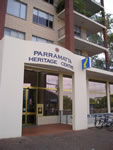 | Parramatta Heritage CentreThis is the place to find all kinds of information about Parramatta. There is bike parking at the front. It includes a number of great displays and very helpful staff. |
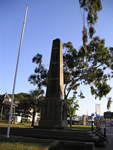 | Prince Alfred ParkSite of the Parramatta's first two gaols. The first, a timber gaol, was completed in 1797 but was burnt down two years later by the inmates. In 1804 a two-storey stone structure was built, the upper floor being used as the first female factory. |
 | St Patrick's Catholic CathedralThe sandstone church on the site was built in 1935, the 4th church on the site. This burnt down in 1996 leaving just a sandstone shell. A completely new church, which incorporates the old one, was opened in 2003. |
 | Riverside WalkThis is a lovely winding path along the north side of the Parramatta river. It is a great place to enjoy a break in your bike ride. |
 | Parramatta Rivercat WharfThis is where you can catch the Rivercat to the city. |
 | HarrisfordThe original Kings School from 1832 to 1835. It was used for other schools until 1865, when it became home to the Harris family, hence its name. |
 | Macarthur St (Gasworks) BridgeOften known as the 'Gasworks bridge' because of the gasworks that once occupied the block southeast of the bridge, it was completed in 1885. The south side of the bridge was the site of Howell's wind and watermill, which was built and 1828 and used until 1868. |
 | Macarthur Girls High SchoolSamuel Marsden had a residence built for his wife on this site in 1835, though she died before it was completed. Called "Newlands", it was demolished in the 1930s. |
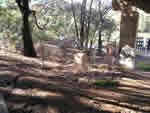 | Boundary stoneErected by George Gipps in 1839, this was one of nine laid by George Gipps to mark the boundaries of Parramatta. You can find surviving markers at the corner of Alice and Weston Streets, and on Oak Street. Other boundary stones can be found at Hambledon Cottage, Boundary and Balfour Sts Northmead, Domain Creek (Parramatta Park), and Alfred and Alice Sts, Harris Park. |
 | Female Orphan SchoolBuilt under Governor Macquarie it opened in 1818 with 70 girls. Girls remained here until they were apprenticed as servants at 13. Elizabeth Macarthur employed girls from the school. In 1888 it was gazetted as a Psychiatric Hospital which it remained until the 1990s when the site was turned over to the University of Western Sydney. |
 | All Saints ChurchBuilt by James Houison and Nathaniel Payten and completed in 1847. It was financed by Samuel Marsden. It was enlarged in the 1860s with spire and bells added. |
 | Elizabeth Street BridgeThis wonderfully designed bridge replaced a narrow old bridge carrying a pipe. It was opened in 2002. |
 | Convict CanalRemains of a convict-built brick barrel drain to the Parramatta river. |
 | Perth HouseBuilt by James Houison around 1841, it was the home of politician George Oakes (1813 - 1881, member for Parramatta of the first Legislative Council of NSW), and a private school in the late 1880s. |
 | Roxy CinemaA beautiful old theatre originally built in 1930. It became a cinema and is now a night club. |
 | Queens WharfThis was once a bustling wharf area, where paddle steamers and overseas sailing ships exchanged their trade goods for agricultural produce. You would have been able to see Old Government House from here. It also housed the commissariat stores. The reserve also houses part of the hull of a former HMAS Parramatta. Much more information can be gleaned from the signboards on the walk. The Harris Park Heritage Walk starts here. |
 | Elizabeth FarmResidence of farming pioneers Elizabeth and John Macarthur, who arrived in 1790. Named after John's wife, it was originally 1100 acres, though only four remain. The Macarthurs also brought Merino sheep from Spain to Australia. They went on to become the biggest land owners in NSW. Elizabeth Farm was built in 1793 and is Australia's oldest privately-owned building. |
 | Our Lady of LebanonThis Maronite church (a branch of the Catholic church) is a significant architectural icon in the area. The building was started on 1963 and completed on 1978. |
 | Experiment Farm CottageJames Ruse was granted land here by Phillip in 1791, the first convict to be granted land. He developed Australia's first private farm. In 1793 he sold it to Surgeon John Harris (after whom Harris Park is named). Harris built the cottage on the site in 1834. |
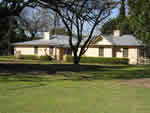 | Hambledon CottageBuilt in 1824 for Miss Penelope Lucas, governess to John and Elizabeth Macarthur's three daughters. |
 | Old School HouseNow part of Arthur Phillip High School, this building was completed in 1876. |
 | Leigh Memorial ChurchCompleted in 1885 it was dedicated to Samuel Leigh, the first Methodist Minister in Parramatta, who preached in the area from 1816. |
 | Kia OraThis was James Houison's own house which he built in the 1840s. Behind where it now stands was a cottage in which John Batman, who went on to found the city of Melbourne, was born. |
 | Centenary SquareThe clock in the square was built in 1888 to mark the Australian centenary. |
 | Town HallBuilt in 1883 on the site of the first agricultural fair held in Australia in 1813. |
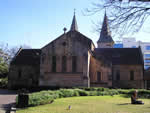 | St John's ChurchThe first church opened on this site in 1803. It became the church of Samuel Marsden, the "Flogging Parson". It was the only church in the colony until 1809. In 1810 Macquarie began remodelling, and the towers were completed in 1819. The original building was demolished in 1851, replaced by the current structure designed by James Houison. The transepts were added in 1882 by Edmund Blackett. |
 | World War I MemorialThis War Memorial, creating an arched entrance to St John's Park, was erected to commemorate those killed in World War I. |